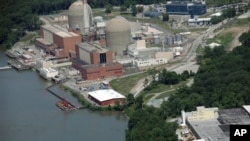Japan's unfolding nuclear disaster has raised the issue of nuclear power plant safety for many other countries, particularly those with nuclear plants in heavily populated and earthquake-prone areas. In the United States, concern centers on California, where two nuclear plants are sited near the ocean, in active earthquake zones.
But some nuclear power plants on the east coast are also raising concerns. On March 16, New York Governor Andrew Cuomo called for a safety review of the Indian Point Energy Center, 61 kilometers north of New York City on the Hudson River, where two reactors, Indian Point 2 and 3, have operated since the mid-1970s. The governor acted after the federal Nuclear Regulatory Commission (NRC) listed Indian Point 3 as the most riskily-sited nuclear plant in the country, and one of many that may need additional strengthening against earthquakes.
New York state officials first moved to block Indian Point's relicensing by the NRC four years ago. They cited concerns that an earthquake or terrorist attack could lead to a dangerous radiation release in a densely populated area that cannot be quickly evacuated. 300,000 people live within 16 kilometers of the plant, and 20 million within 80 kilometers.
Attorney Phillip Musegaas is Hudson River program director for the environmental group Riverkeeper, which is also suing the NRC to close Indian Point. "We have a litany of concerns about this plant," he said in an interview on the west bank of the Hudson, across from Indian Point. "It has oil spills, it literally has explosions, it has frequent unplanned shutdowns, it has radioactive water leaks. It causes impacts on Hudson River fish species, from the cooling-water intakes."
Earthquakes are another concern, he said. The Indian Point plant was built above an inactive earthquake fault, the Ramapo Fault. Indian Point's owner, the Entergy Corporation, says the facility was built to withstand an earthquake up to magnitude 6.1 on the Richter scale. However, a 2008 study by Columbia University earthquake scientists reported on another system of faults near the plant that intersect with the Ramapo Fault. The study concluded that the area is more vulnerable to larger earthquakes, measuring 6 or even 7 - than previously believed.
Columbia University professor Won-Young Kim, a co-author of the study, said that an earthquake as powerful as 6 on the Richter scale is likely to happen in the area only once every 670 years. In any given 50 years, the chance is estimated at seven percent. With a magnitude 6 earthquake, he said, "You can expect some damage, not in [the] reactor building, but in peripheral supporting buildings, like in this case in Japan."
However, Entergy spokesman Jim Steets said that the company had done a new safety study following the Columbia report. "And the NRC has also done that, and decided that Indian Point is safe," Steets said, "[and] that the requirements that were put in place years ago, that would enable us protections against a range of earthquakes, are still valid today in terms of that capability."
The direct cause of Japan's nuclear disaster was not the earthquake or tsunami, but the sustained loss of electrical power to pump the water needed to cool the fuel, Riverkeeper's Phillip Musegaas observed. He said Indian Point is vulnerable to both weather emergencies and terrorist attack, and that the spent-fuel pools are particularly dangerous.
"If those catch on fire, you have a massive release of radiation, because they are not in a containment building," Musegaas said. "They are basically in a cinderblock industrial building with a metal roof. And if these fires continue for long enough, they can be unstoppable. So, this is a very big risk. To put it in perspective, the spent fuel pool at a nuclear reactor contains normally about five times as much radiation as the reactor core itself."
But Entergy's Jim Steets said that the spent fuel is submerged in a pool of water 8.5 meters deep, and that Indian Point has multiple back-up electrical systems to keep its cooling systems operating even during hurricanes. Because the plant is located so far inland, he noted, it is not vulnerable to tsunamis. "I don't think there's a reasonable scenario where you could claim that plant's not going to be operated safely, or you know, managed safely," Steets added.
Another issue was raised last October, however, when nuclear industry consultant Paul Blanch petitioned the NRC to review the safety of two large, highly-pressurized natural-gas lines that run within 150 meters of critical Indian Point structures. A rupture from corrosion, sabotage or even a small earthquake could cause a huge natural gas explosion, Blanch wrote, with a force equivalent to 15,000 tons of TNT. He said such an explosion and fire would likely damage or destroy many of the nuclear plant's systems and could possibly lead to a "significant" release of radioactivity.
The NRC said it is now reviewing Blanch's petition to decide if the issues he raises merit further investigation. The agency is expected to rule within a year or so on relicensing Indian Point's two nuclear plants for 20 more years, before their current licenses expire in 2013 and 2015.










